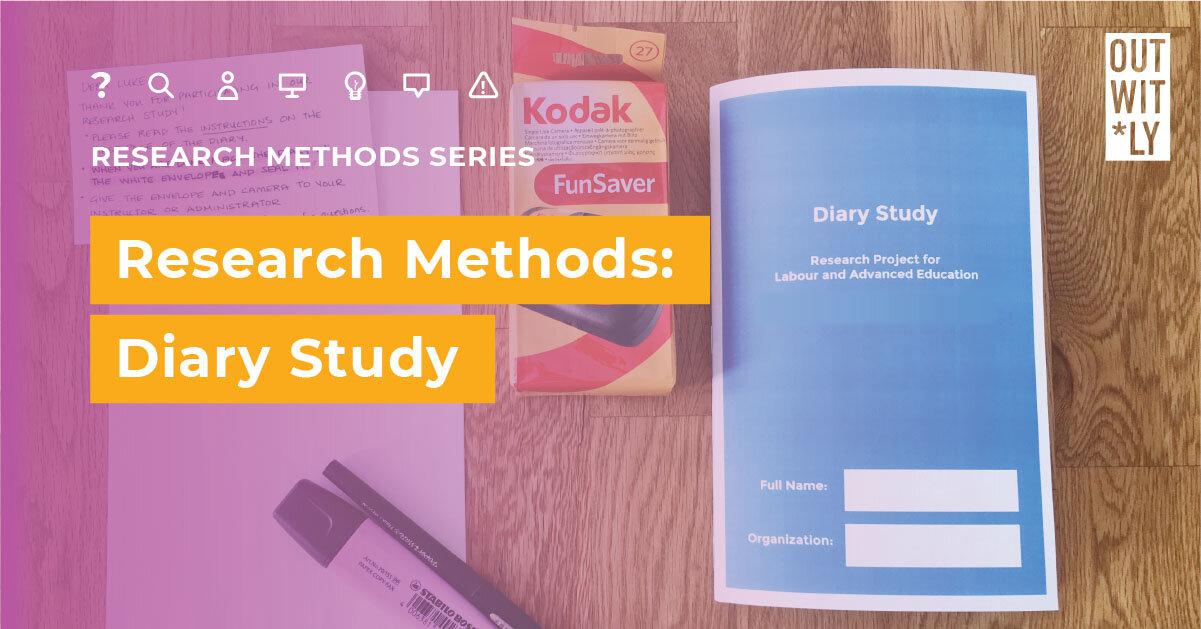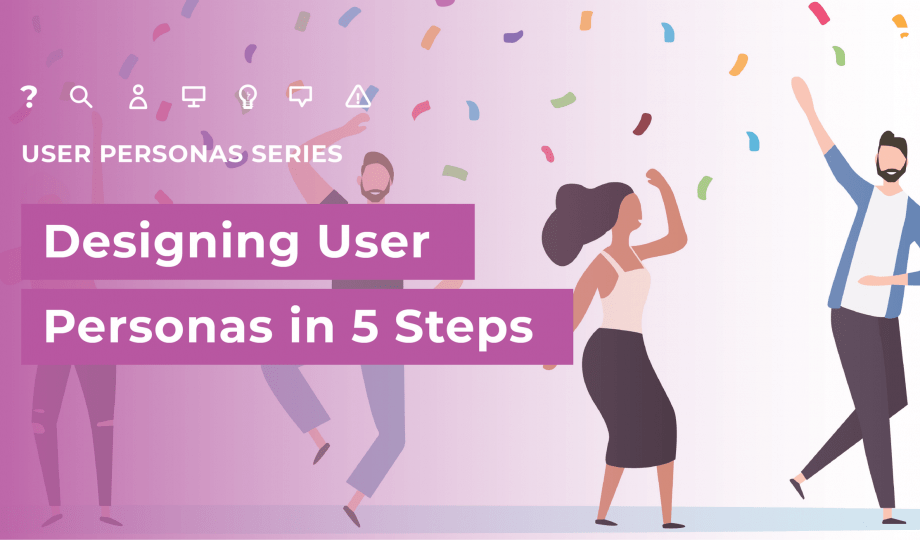In our new three-part blog series, we’ll introduce our favourite qualitative research methods and strategies that you can immediately start applying to your human-centered design (HCD) projects.
We will cover the following design research methods:
-
Diary Studies (this post).
In this final instalment, we’re explaining the benefits of conducting Diary Studies to better understand your users’ experiences and motivations over a longer period of time.
What is a diary study?
A diary study involves research participants (your users, customers, or target audience) journalling and self-reporting their activities, their thoughts and feelings, and their general experiences over a specified period of time. The participants are in charge of what they log, but this mode of research gives them many opportunities over the course of several weeks to add and jot down details they may not remember to mention during an in-person interview or observation session.
These studies are usually conducted over the span of several weeks, and while they are sometimes an analogue exercise (think: a paper booklet and a pen), they also involve users taking photos and videos of their experiences. Increasingly, online diary studies are becoming more common, with researchers using instant messaging apps (like WhatsApp), email, and mobile SMS. Diary studies should generally be used in conjunction with other research methods, like in-depth interviews, observations or shadowing, and surveys.
When should you conduct a diary study?
Diary studies are a great way to capture and learn more about a user’s experience over time, particularly when conducting a human-centered design (HCD) or UX research project. This can be logistically difficult and expensive to do through observations, where you are more likely to only capture a user’s experience at one point in time over a few hours or one day.
Diary studies are best to use when you are trying to understand or create a journey map of your customers’ interactions with your organization, product, or service. For example, we conducted a diary study with mothers who use coupons at grocery stores. We wanted to find out, over the course of one month, how these women went about finding coupons online and in flyers, how often they went grocery shopping, what their frustrations around couponing and grocery shopping were, and how they communicated with their families and partners about the grocery shopping list. The outcome of the diary study was a journey map showing their experiences couponing and grocery shopping, and it also highlighted areas of opportunity for innovation for our client who was developing a grocery shopping app with integrated coupons.
In a second project, we conducted a diary study with adult learners to see how school did or did not fit into their adult lives and schedules, as many of them also had work and family responsibilities beyond school. This study helped us uncover major learning barriers, like transportation and childcare, which in turn enabled us to be more creative in figuring out how to alleviate some barriers so that adult learners would have an enhanced learning experience––and be able to make it to class more often.
How can you setup a diary study?
Participants: As always, you’ll want to think carefully about who to recruit for diary studies. Aim to have 3–5 participants per user group–this way, you have consistency in your data, you’ll be better able to identify commonalities and patterns, and you are getting enough diversity and varied perspectives. In a future blog post, we’ll explain best practices for recruiting for research studies (so stay tuned!)
Format/Medium (Online vs. Offline): Will your diary study be conducted on paper or online? Will participants be asked to write down their thoughts and feelings in some form of booklet, or will your study be chiefly conducted with technology, such as a smartphone or computer? This should be one of your first decisions when planning a diary study. You can decide best by considering two factors: privacy (i.e. is it okay to be collecting personal information via a mobile app or a cloud-based application?), and most importantly, your research participants. Will they be comfortable using technology? Do they have regular access to the Internet? Do they own a smartphone or computer? It’s easy to take certain technologies for granted. In reality, not all research studies will be conducted with people who use (or can afford) technology.
Next, once you’ve selected a medium for the study, you can begin to plan the logistics, like assembling/printing journals, mailing them to participants, costs, whether to include a disposable camera, or which application to use for a more technologically-driven diary study. There are some very cool apps out there for “mobile missions” or digital diary studies, like d.scout. Or you can DIY a digital study using Google Drive or an online survey tool like Typeform.
Duration: Now that you’ve identified your participants and decided on the right format for your diary study, you’ll need to determine the duration of the study, the overall frequency for participants to be logging their thoughts, and how long each day you’ll expect them to spend answering questions. For this, you should think about what a realistic goal might be for the users you’ve selected. At Outwitly, a two-week diary study is normally our default if we expect users to be filling out the diary on a daily basis. In the grocery shopping example, the duration of the study was longer because we knew that the participants would only be engaging in these activities once or twice per week. As such, we chose to run the study over a one-month period, knowing the users wouldn’t be filling out the diary or taking pictures every single day. We also like to give participants 5–10 questions that they must respond to every time they log their thoughts. These questions should not take them more than 10–20 minutes to complete in one sitting.
Incentives: To facilitate recruiting, especially for diary studies where the time investment for participants is quite high, we encourage the use of incentives. This could be a $100 gift card to Amazon or a Paypal gift card (…we like to use gift cards). Just be mindful, again, of your research participants. Keep in mind whether they might be comfortable using electronic gift cards, and where they typically shop. You can also have physical Visa gift cards mailed to their homes. And always be mindful of the monetary amount––what can the project afford, and what is a fair incentive for their time?
Build your Diary Study: You are ready to put your diary together! If you’ve chosen an offline diary study, then you will need to assemble and print a booklet for participants to fill out. Think carefully about what types of questions you want to ask.
The typical structure of a diary might include the following:
-
A title page (with the participant’s name)
-
An introduction page with clear instructions and expectations for how often logging should happen
-
A question page (with your 5–10 questions and room for answers) for every day you expect your participant to be filling in the diary
-
A wrap-up page with different, concluding questions to be filled out at the very end of the study.
Here are some examples of daily questions we like to use:
-
What did you do today?
-
What did you like the most about [task/activity]?
-
What did you like the least about [task/activity]?
-
How could that have been made better for you?
-
How did you feel about your experience [doing task/activity] today?
-
Why did you feel that way?
-
Did anything get in your way?
We also give instructions for any photographs or videos we want them to take each day.
Once you’ve written your questions, either assemble your diaries and print/bind them, or post them in your digital tool of choice. If you are using an offline diary, then you’ll need to hand out or mail out the physical diaries to your participants. If you would like them to take photos as well, consider sending a disposable camera along with the diary. (Of course, if they use smartphones, it is much easier to have them send you photos with their phone by text or email!)
Click through to see a sample diary booklet…
Bookend the Study with Interviews: Typically, a diary study would be book-ended by in-depth interviews, either conducted over the phone or in-person. You’d conduct a preliminary interview with the participant to gather important background information about who they are, what their typical day looks like, overall likes and dislikes of the product or service, and so on. A preliminary interview is also a great time to introduce the diary study, to explain how it works, and to set their expectations.
As part of your preliminary interviews with the research participants, you can set the general expectations for the diary study. You’ll want to confirm and explain the following:
-
When should they expect to receive the diary study kit in the mail?
-
What can they expect to find inside the diary study kit?
-
What is the duration of the diary study, and how often do you expect them to fill out their diary? (i.e. everyday for two weeks, only during weekdays for a month, etc.)
-
How much time can they expect to spend filling out the diary on the days they’ll be completing it?
-
How often do you want them to take photographs? What kind of photos do you want them to take? (We like to give them a precise number––i.e. aim for 5 photos per day).
-
How and when can they send the completed diary back to you?
-
Confirm their physical or email address for sending the diary study kit and any incentives once the study has finished.
Need help planning and conducting user interviews? Use our Plan A Stellar User Interview Workbook! We’ve got you covered.
The follow-up or wrap-up interview should occur within a week after the diary study period has ended. Once you’ve had a chance to review everything the participant has written, this interview gives you the chance to ask about anything else you’d like more detail or clarity about. Ask some concluding questions, ask how they felt about the study, and remember to thank them for their time!
Analyze Your Data
Once the diary study is complete and you’ve received all of the photos and diaries back from participants, it’s time to analyze and make sense of the data. There is an entire science related to data analysis, but for diary studies, we like to type-up responses in a spreadsheet so we can easily see trends and patterns at a glance. Once you’ve analyzed the data, you can create user journey maps in chronological order, and mark pain points and opportunities over time. This is the human-centered design process at work!
Next, we begin starting our new User Personas blog series. Does your organization or team have a set of customized user/customer personas? We’ll explain why they are crucial for your business, and we’ll offer tips for crafting a set of your own!
Resources we like…
-
Great list of diary study resources for UX and design thinking
-
Benjamin Humphrey’s Guide to Running Mobile Diary Studies with SMS
-
D.Scout for Digital Diary Studies
-
Typeform for Online Surveys
Related Posts
-
Our research methods posts about in-depth interviews and observations





